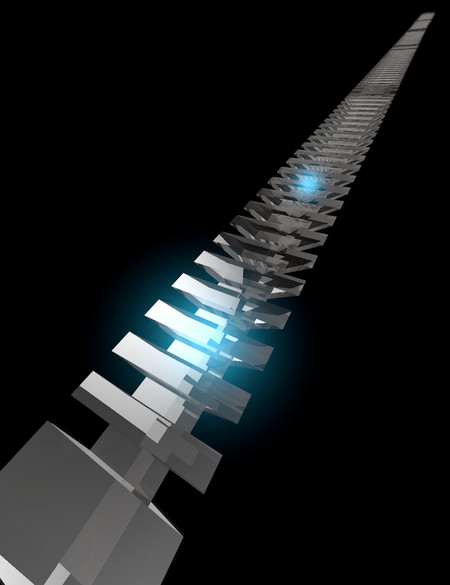By Jean-Jacques DeLisle, contributing writer
Fully quantum computing and networking technologies are the modern Holy Grail of science and technology. Promising massive computing capability in small and efficient packages that make modern high-performance computing technologies look like IBM computers from the ’70s, quantum computing technology has captured the imagination and research funding from many universities and national organizations from around the globe. Though memory is only a small part of complex quantum computing and networking system, it’s a critical component that researchers from Caltech and the University of Verona in Italy have been working on for several years. Earlier this month, Caltech announced a recent development, the first on-chip nanoscale optical quantum memory.

The technology enables better control of the interactions between individual photons and atoms. Image source: Ella Maru Studio.
Like traditional computer memory, quantum memory stores digital information. However, quantum memory is also able to utilize several potentially advantageous quantum phenomena, such as superposition. Moreover, quantum memory, like in this international research program, only requires a single photon per memory cell, which can enable drastically faster, more efficient, and secure memory.
“This technology not only leads to extreme miniaturization of quantum memory devices, it also enables better control of the interactions between individual photons and atoms,” said Tian Zhong, the lead author of the study and a Caltech postdoctoral scholar, in a press release. Photons are attractive for use as a memory conveyance, as they are without mass and charge and can be sent along EMI-resistant fiber optic lines.
The international research team led by Andrei Faraon, assistant professor of applied physics and materials science in the Division of Engineering and Applied Science at Caltech, used optical cavities fabricated from rare-earth ion doped crystals to store the photons. The 700-nanometer-wide and 15-micron-long modules for housing the crystal cavities were machined using focused ion-beam milling and were cooled to 0.5 Kelvin prior to photon insertion. A single photon was pumped into the cavity by a heavily filtered laser and was absorbed by the rare-earth ions until retrieval.
After 75 nanoseconds, the photons were retrieved and tested to ensure that the original data was intact. A comparison of the wave function of the photons before and after the insertion was used to confirm that the devices were true memory devices. The retrieved photons exhibited a 97% success rate, according to Faraon.
Though the experimental setup may appear quite large and cumbersome compared to traditional solid-state memory, the researchers claim that their nanoscale optical quantum memory can potentially be integrable with chip-scale photon sources and detector devices. Though likely years away, further developments could prove this technology as a practical method of implementing quantum memory in high-performance devices. “The storage time and the overall device efficiency must be further improved in order to evolve this technology into practical devices,” Faraon told Electronic Products. Future development could lead to multiplexed quantum and classical information processing for networking and data center systems.
Advertisement
Learn more about Electronic Products Magazine





